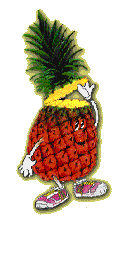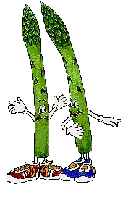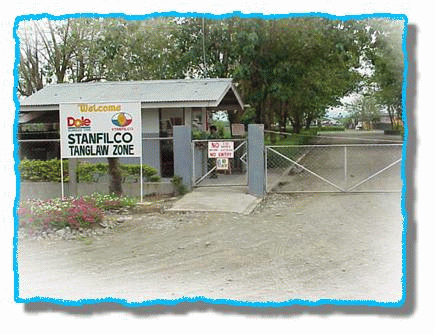|
.gif)
 DOLEFIL DOLEFIL
DOLE PHILIPPINES INCORPORATED started operations on June 24, 1963 with the establishment of Dolefil as the first Philippine division.
Dolefil is a prime producer and exporter of fresh and canned pineapples.
The Dolefil plantation sits at the foot of the majestic Mt. Matutum in Polomolok, South Cotabato - a place which boasts of its rich, volcanic soils ideal for pineapple cultivation.
Along the concept of total quality control, Dolefil installed its own can manufacturing plant in 1968, and a box manufacturing plant in 1976.
The present can making machines are capable of producing more than a million cans a day. The box plant supplies all the box requirements of Dolefil including that of its sister divisions.
Since its first harvest in 1965, tonnage has been increasing steadily. At present, the cannery can process up to 110 tons of fruit per hour.
Indeed, Dolefil today operates the world's largest and most modern pineapple cannery.
The 1970's marked a shift in consumer food-buying habits. Consumers were preferring "natural" to processed food. Dolefil responded by stepping up its production of fresh and "select" quality pineapple.
Today, Dolefil supplies 63% of Japan's annual fresh pineapple demand, and exports about 7.5 million boxes per year to all of its fresh pineapple markets which also include New Zealand, China, Hongkong and the Middle East.
Dolefil's plantation spans some 24,000 acres, to maintain an annual production of almost 500,000 tons.
Today, Dolefil has 4,100 employees and uses a large number of contractor's to support its daily operations.
Dolefil proved to be a boon not only to the employees but to the community and the country, as well.
The arrival of Dolefil turned Polomolok from a sixth class to a first class municipality almost at once. Furthermore, as an export-oriented company, Dolefil brings in significant dollar earnings for the country.
.gif)
 STANFILCO STANFILCO
In 1966, Dole Philippines pioneered the country's banana industry with the establishment of its second division, STANFILCO.
STANFILCO started exporting giant cavendish bananas in 1968, setting a record as the Philippines' first banana exporter.
STANFILCO traces its earliest beginnings to a firm established in New Orleans. Then known as the Vaccaro Brothers and Company, it added shipping to its banana importing business and consequently changed its name to Standard Fruit and Steamship Company.
Dole Food Company bought 55 percent of Standard Fruit in October 1964, and fully acquired the company four years later.
General Santos was chosen as the first site of the Philippine banana project. Banana seeds from Honduras and Costa Rica arrived in general Santos on September 2, 1966. These seeds were planted on a 73-hectare lot which served as the nucleus of the project.
In 1967, the germinated seeds were distributed to the farmers for commercial planting. On November 2, 1968, Stanfilco's maiden shipment of 4, 138 boxes was made.
Following the success in general Santos the company expanded to the hinterlands of North Davao.
First planting in Davao was in April of 1969, on 81 hectares in Manay and Mabuhay, two farms located in Stanfilco's Panabo Zone at present.
Expansions continued immediately after in Luna Zone.
Rapid expansions at the onset of the 90's were made in the presently called Compostela, Tanglaw, Osmiguel and Dole Valley Zones.
Following these expansions, STANFILCO now covers 9,000 hectares of banana plantation and exports over 30 million boxes of bananas annually to its markets in Japan, Korea, Hongkong, China, New Zealand and the Middle east.
In the Philippines, STANFILCO pioneered the effective implementation of the Independent Growers Program - A unique farming concept that allows local farmers to grow bananas for STANFILCO while retaining full control of their land and operations.
Over the years, 2,000 growers and nearly 10,000 associate contractors partnered up with STANFILCO under this program.
STANFILCO also proudly counts itself as one of the few companies who pioneered the introduction and implementation of Total Quality Management or TQM in the agro-industrial sector of the Philippines.
Having helped bring the Dole bananas to dominance in the Philippines and the markets, STANFILCO looks forward to spend many more years in the apex of the banana industry through continued improvement and quality.
.gif)
 TROPIFRESH TROPIFRESH
During the 1980's, DOLE JAPAN expanded its product line of bananas and pineapples to include an array of other fresh produce to offer its customers.
DOLE PHILIPPINES has played a key role in meeting these new customer requirements by introducing new products that meet the high quality standards demanded in Japan.
From this effort was born DOLE PHILIPPINE's newest division, Dole Tropifresh.
Tropifresh, formally organized in 1990, began its operations growing and shipping four products, fresh asparagus, anthurium cutflowers, leatherleaf fern and solo papaya.
Near its headquarters in Polomolok, South Cotabato, tropifresh has more than 600 asparagus growers on 1,000 hectares of land producing the crop and delivering it to a company packing plant in Tupi.
Nearby is a large anthurium shadehouse and packing house.
Near Davao, Tropifresh has developed a line of solo papaya for customers in Japan that rivals the famous solo papaya in Hawaii for appearance and taste.
In Davao del Norte, the company has a shadehouse with leatherleaf fern.
Tropifresh is the leader of small number of companies in the Philippines that produce these kinds of new products for customers in Japan and other markets.
Since 1995, Tropifresh has moved to stay in the forefront of Philippine agricultural production by developing additional vegetable and cutflower crops in an area in Bukidnon.
In its entire product line, Tropifresh has done more just develop new farming practices to grow new crops.
The associates of tropifresh have also developed new methods of packing, storing and transporting its products at a low cost. They have spared no effort to deliver high quality products at a reasonable cost to customers.
Tropifresh is now recognized in Asia as a true pioneer in the business of high value crops.
Dole has a long tradition of quality, innovation and community service.
What has first inspired Dole's pioneers in building the company is the same spirit that dwells among their successors.
As a new millennium begins to unfold, Dole prepares to face the challenges of the future.
Changes may occur, names may vary, but a shared Dole visions and mission will carry the company well into the future.click to download.
Click this Dole
Philippine Brochure
Back to About Stanfilco
|
.gif)
.gif)


 DOLEFIL
DOLEFIL STANFILCO
STANFILCO TROPIFRESH
TROPIFRESH